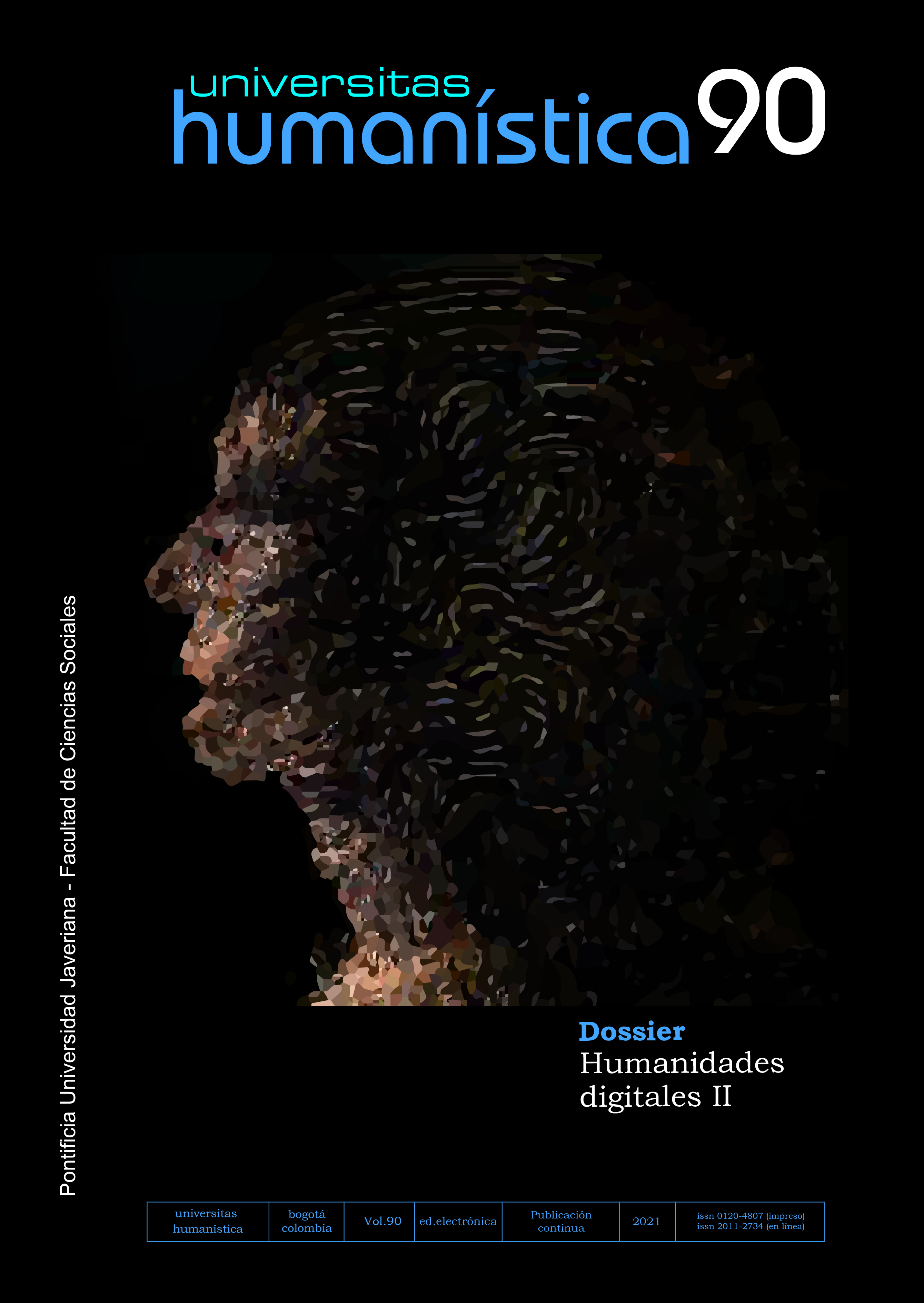Alexa (2018). Top sites in Colombia. https://www.alexa.com/topsites/countries/CO
Barredo-Ibáñez, D. y Díaz-Cerveró, E. (2017). La interactividad en el periodismo digital latinoamericano. Un análisis de los principales cibermedios de Colombia, México y Ecuador. Revista Latina de Comunicación Social, (72), 273-294. http://www.revistalatinacs.org/072paper/1165/15es.html
Blei, D. M., Ng, A. Y., y Jordan, M. I. (2003). Latent Dirichlet Allocation. Journal of Machine Learning Research, (3), 993-1022. http://www.jmlr.org/papers/volume3/blei03a/blei03a.pdf
Bozeman, B. (2007).Public values and public interest: Counterbalancing economic individualism. Georgetown University Press.
Brown, D., Soto-Corominas, A., Suárez, J. L., y De la Rosa, J. (2016a). Chapter 9: Overview – The Social Media Data Processing Pipeline. In L. Sloan, The SAGE Handbook of Social Media Research Methods. http://dx.doi.org/10.4135/9781473983847.n9
Brown, D., Soto-Corominas, A., y Suárez, J. (2016b). The Preliminaries Project: Geography, Networks, and Publication in the Spanish Golden Age. Digital Scholarship in the Humanities, 32(4), 709–732. https://doi.org/10.1093/llc/fqw036
Cifras y Conceptos (2019). Panel de opinión. Bogotá. http://cifrasyconceptos.com/productos-panel-de-opinion/
Cochran, C. (1974). Political Science and “The Public Interest”. The Journal of Politics, 36(2), 327-355. www.jstor.org/stable/2129473
Dahlgren, P. (2009). Media and Political Engagement: Citizens, Communications and Democracy. Cambridge University Press.
DiMaggio, P. (2014). Cultural Networks. In J. Scott y P. J. Carrington, The SAGE handbook of social network analysis (pp. 286-300). SAGE Publications. DOI: 10.4135/9781446294413.n20
DiMaggio, P., Nag, M., y Blei, D. M. (2013). Exploiting Affinities between Topic Modeling and The Sociological Perspective on Culture: Application to Newspaper Coverage Of U.S. Government Arts Funding. Poetics, (41), 570-606. https://doi.org/10.1016/j.poetic.2013.08.004
Fraser, N. (1990). Rethinking the Public Sphere: A Contribution to the Critique of Actually Existing Democracy. Social Text, (25/26), 56-80. https://carbonfarm.us/amap/fraser_public.pdf
Gómez Buendía, H. (2018). La inteligencia de Colombia nos cree. El Espectador https://www.elespectador.com/entretenimiento/un-chat-con/hernando-gomez-buendia-la-inteligencia-de-colombia-nos-cree-articulo-819206
Gómez Buendía, H., Vicente, C. y Franche, M. A. (2003). El conflicto, callejón con salida. http://hdl.handle.net/20.500.12010/13541
Gutiérrez Coba, L. y García Perdomo, V. (2016). Colombia. En R. Salaverría, Ciberperiodismo en Iberoamérica (pp. 79-96). Fundación Telefónica, Editorial Ariel.
Habermas, J. (1989). The Structural Transformation of the Public. Cambridge MIT Press.
International Communication Union (2019). Percentage of individuals using the Internet. https://www.itu.int/en/ITUD/Statistics/Documents/statistics/2019/Individuals_Internet_2000-2018_Jun2019.xls
Johnston, J. (2017). The public interest: A new way of thinking for public relations? Public Relations Inquiry, 6(1), 5-22. https://doi.org/10.1177/2046147X16644006
Maier, D., Waldherr, A., Miltner, P., Wiedemann, G., Niekler, A., Keinert, A., Pfetsch, B., Heyer, G., Reber, U., Häussler, T., Schmid-Petri, H., y Adam, S. (2018). Applying LDA Topic Modeling in Communication Research: Toward a Valid and Reliable Methodology. Communication Methods and Measures, 12(2-3), 93-118. https://doi.org/10.1080/19312458.2018.1430754
Marin, A., y Wellman, B. (2014). Social Network Analysis: An Introduction. In J. Scott y P. J. Carrington, The SAGE Handbook of Social Network Analysis (pp. 11-25). SAGE Publications. DOI: 10.4135/9781446294413.n2
Meléndez Yúdico, J. (2015). Primer estudio de medios digitales y periodismo en américa latina. http://www.nodal.am/wp-content/uploads/2016/01/Primer-estudio-de-medios-digitales-y-periodismo-en-Am%C3%A9rica-Latina.pdf
Nolan, K., y Setrakian, L. (2014). “Seeking the single subject news model”. Columbia Journalism School. http://towcenter.org/research/seeking-the-single-subject-news-model/
Rauchfleisch, A. (2017). The Public Sphere as an Essentially Contested Concept: A Co-Citation Analysis of The Last 20 Years of Public Sphere Research. Communication and the Public, 2(1), 3-18. https://doi.org/10.1177/2057047317691054
Razón Pública (2009). ¿Qué es Razón Pública? https://www.razonpublica.com/index.php/qus-razca-mainmenu-61.html
Razón Pública (2016). Acta No 17 de Asamblea General Extraordinaria (reforma de los estatutos). https://consultaimagenesob.ccb.org.co/OnBaseDMZ/docpop/docpop.aspx
Reuters Media Institute (2018). Global News Report. http://media.digitalnewsreport.org/wp-content/uploads/2018/06/digital-news-report-2018.pdf
Rey, G. y Huertas, C. E. (2010) Periodismo digital en Colombia: el quién y el cómo de los nuevos medios. Universidad Javeriana. http://consejoderedaccion.org/webs/documentos/Estudio_medios_digitales_2010.pdf
Rey, G. y Huertas, C. E. (2012) Medios digitales en Colombia: agendas periodísticas y sostenibilidad. Universidad Javeriana. http://www.consejoderedaccion.org/images/documentos/emprendimiento/estudio_medios_digitales_2012.pdf
Salaverría, R. (2016). Ciberperiodismo en Iberoamérica marco general. Fundación Telefónica, Editorial Ariel.
Suárez, J. L., McArthur, B., y Soto-Corominas, A. (2015). Cultural Networks on Culture and Computing. International Conference on Culture and Computing, Kyoto. http://www.cultureplex.ca/wp-content/uploads/2017/09/074332381.pdf
Wheeler, C. (2006). The Public Interest: We Know it is Important, But Do We Know What It Means. AIAL Forum, (48), 12-25. https://search.informit.org/doi/10.3316/IELAPA.200605460
Ylä-Anttila, T., Eranti, V., y Kukkonen, A. (2018). Topic Modeling as a Method for Frame Analysis: Data Mining the Climate Change Debate in India and the USA. https://doi.org/10.31235/osf.io/dgc38
Zuluaga, J., y Martínez, M. P. (2012). Mapping Digital Media. Colombia. https://www.opensocietyfoundations.org/publications/mapping-digital-media-colombia

This journal provides immediate open access to its content on the principle that making research freely available to the public, encourages greater global exchange of knowledge.
The journal Universitas Humanística is registered under a Creative Commons Attribution 4.0 International Public License. Thus, this work may be reproduced, distributed, and publicly shared in digital format, as long as the names of the authors and Pontificia Universidad Javeriana are acknowledged. Others are allowed to quote, adapt, transform, auto-archive, republish, and create based on this material, for any purpose (even commercial ones), provided the authorship is duly acknowledged, a link to the original work is provided, and it is specified if changes have been made. Pontificia Universidad Javeriana does not hold the rights of published works and the authors are solely responsible for the contents of their works; they keep the moral, intellectual, privacy, and publicity rights.
Approving the intervention of the work (review, copy-editing, translation, layout) and the following outreach, are granted through an use license and not through an assignment of rights. This means the journal and Pontificia Universidad Javeriana cannot be held responsible for any ethical malpractice by the authors. As a consequence of the protection granted by the use license, the journal is not required to publish recantations or modify information already published, unless the errata stems from the editorial management process. Publishing contents in this journal does not generate royalties for contributors.


